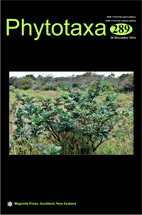Abstract
Many phenotypical features traditionally used to classify genera in Parmeliaceae and in lichens in general have evolved several times independently, potentially limiting their taxonomic utility. Here, we aim to elucidate evolutionary relationships of Canoparmelia s. lat. among other parmotremoid taxa. A multilocus dataset (ITS, nuLSU and mtSSU rDNA sequences) was gathered and analyzed within a phylogenetic framework. Canoparmelia s. lat. was recovered as highly polyphyletic within the parmelioid clade, and three divergent lineages representing Canoparmelia s. lat. were identified in addition to the previously segregated Crespoa group. Of these, two formed a sister relationship with Parmotrema. However, no apparent diagnostic morphological features were found distinguishing the distinct Canoparmelia s. lat. clades reconstructed in the phylogenetic analyses. As a consequence, we propose to restrict the circumscription of Canoparmelia to clade 1 (i.e. the C. texana group) and to include clades 2 and 3 in Parmotrema. We propose to recognize these well-supported monophyletic clades at subgeneric level. Consequently, the new subgeneric name Parmotrema subgen. Africanae is proposed for clade 3 recovered in this study. Since clade 4, which clusters with the genera Nesolechia and Punctelia, is only represented by a single sequenced specimen, we refrain from proposing any taxonomic changes. The new combinations Parmotrema epileucum, and P. zimbabwense are proposed.

